The Earth, with its atmosphere and oceans, its complex biosphere, its crust of relatively oxidised, silica rich, sedimentary, igneous, and metamorphic rocks overlaying [a magnesium silicate mantle and core] of metallic iron, with its ice caps, deserts, forests, tundra, jungles, grasslands, fresh-water lakes, coal beds, oil deposits, volcanoes, fumaroles, factories, automobiles, plants, animals, magnetic field, ionosphere, mid-ocean ridges, convincing mantle... is a system of stunning complexity. J. S. Lewis, American Geologist 54
 |
An imaginary space-traveler approaching the solar system from interstellar space would encounter a very interesting scene. Let us imagine that we are such travelers and that we're arriving at the plane of the ecliptic–the great circle of the celestial sphere in which all the major planets of our solar system move. The first planet we will meet is Pluto. This planet is quite a cold place. The temperature is around -238°C. The planet has a thin of atmosphere that is in a gaseous state only when it draws slightly nearer to the sun in its rather elliptical orbit. At other times, the atmosphere becomes a mass of ice. Pluto, briefly, is a lifeless sphere enveloped in ice.
Advancing towards the Sun, you next encounter Neptune. It is cold too: approximately -218°C. The atmosphere, consisting of hydrogen, helium and methane, is poisonous for life. Winds blowing nearly 2,000 kilometers an hour blast across the surface of the planet.
Next is Uranus: a gaseous planet with rocks and ice on its surface. The temperature is -214°C and the atmosphere again consists of hydrogen, helium and methane–unsuitable for human beings to live in.
You reach Saturn after Uranus. This is the second biggest planet in the solar system and is particularly notable for the system of rings encircling it. These rings are made up of gases, rock and ice. One of the many interesting things about Saturn is that it is composed entirely of gas: 75% hydrogen and 25% helium and its density is less than that of water. If you want to "land" on Saturn, you'd better produce your spaceship to be like an inflatable boat! The average temperature is again very low: -178°C.
 |
| Allah gökleri ve yeri hak olarak yarattı. Şüphesiz, bunda iman edenler için bir ayet vardır. |
Coming up next is Jupiter: the biggest planet in the solar system, it is 318 times the size of Earth. Like Saturn, Jupiter is also a gaseous planet. Since it is difficult to distinguish between "atmosphere" and "surface" on such planets, it is hard to say what the "surface temperature" is but in the upper reaches of the atmosphere, the temperature is -143°C. A notable feature of Jupiter's atmosphere is something called the Great Red Spot. It was first noticed 300 hundred years ago. Astronomers now know that it is an enormous storm system that has been raging in the Jovian atmosphere for centuries. It is big enough to swallow up a couple of planets the size of Earth whole. Jupiter may be a visually thrilling planet, but it's no home for people, who would be killed instantly by its freezing temperatures, violent winds, and intense radiation.
Then comes Mars. The atmosphere of Mars cannot sustain human life because it is mostly carbon dioxide. The surface is everywhere pocked with craters: the result of eons of meteor impacts and strong winds blowing across the surface that can raise sandstorms that last for days or weeks at a time. The temperature varies rather much but drops as low as -53°C. There has been much speculation that Mars might harbor life, but all the evidence shows that this is a lifeless world too.
Speeding away from Mars and heading toward the Sun, we notice a blue planet that we decide to skip for the time being while we explore some more. Our search brings us to a planet called Venus. This planet is everywhere shrouded in brilliant white clouds but the temperature at the surface is 450°C, which is enough to cause lead to melt. The atmosphere is composed mostly of carbon dioxide. At the surface, the atmospheric pressure is equal to 90 terrestrial atmospheres: on Earth, you'd have to descend a kilometer into the sea before you reached a pressure that high. The atmosphere of Venus contains layers of gaseous sulfuric acid several kilometers deep. When it rains on Venus, it isn't raining rain you know: it's raining acid. No human or other life could exist in such a hellish place for a second.
We press on and come to Mercury, a small, rocky world, blasted by the heat and radiation of the Sun. Its rotation has been so slowed down by its proximity to the Sun that the planet makes only three full axial rotations in the time it takes to revolve twice around the Sun. In other words, two of Mercury's "years" is equal to three of its "days". Because of this prolonged diurnal cycle, one side of Mercury becomes extremely hot while the other is extremely cold. The difference between the daytime and nighttime sides of Mercury is as much as 1,000°C. Of course such an environment cannot support life.
 |
| Even Mars, the only other planet in the solar system to come close to resembling the Earth physically, is nothing but an arid, lifeless ball of rock. |
To sum up, we've taken looks at eight planets and not one of them, including their fifty-three satellites offers anything that might serve as a haven for life. Each of them is lifeless ball of gas, ice, or rock.
But the blue planet Earth, that we skipped over a while ago? That one's very different from the others. With its hospitable atmosphere, surface features, ambient temperatures, magnetic field, and supply of elements and set just the right distance from the Sun, it is evident that it was specially created to be a home for life.
THE INFERNAL SURFACE OF VENUS |
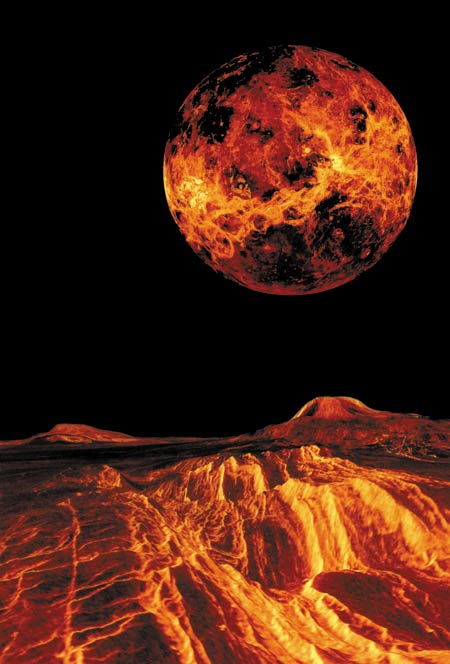 |
| The surface temperature on Venus reaches as high as 450° C, which is sufficient to melt lead. The surface of this world resembles a ball of fire covered with lava. Its atmosphere is thick with sulfuric acid and a sulfuric acid rain falls constantly. The atmospheric pressure at the surface is 90 times that of Earth: the equivalent of a depth of 1,000 meters beneath the sea. |
In the rest of this chapter we will be examining features of earth that make it clear that our planet was created specifically for the support of life. But before we do that, we need to make a brief digression in order to avoid the possibility of any misunderstanding. This digression is especially for those who are in the habit of recognizing the theory of evolution as a scientific truth and who strongly believe in the concept of "adaptation".
"Adaptation" is the noun form of the verb "adapt". "Adapt" implies a modification according to changing circumstances. As used by evolutionists, it means a "modification of an organism or its parts that makes it more fit for existence under the conditions of its environment". The theory of evolution claims that all life on earth is derived from a single organism (a single common ancestor) that itself came into being as a result of chance and the theory makes heavy use of this sense of the word "adaptation" to support its case. Evolutionists hold that living organisms change into new species by adapting to their environment. We have discussed the invalidity of this claim, that mechanisms of adaptation to natural conditions in living beings come into play only under certain circumstances and it can never transform one species into another in detail in our other books.55 (This is summed up in the appendix "Evolution Deceit" in this book) The theory of evolution with its concept of "adaptation" is really just a form of Lamarckism, a theory of organic evolution that holds that environmental changes cause structural changes in animals and plants that can be transmitted to offspring–a theory that has been soundly and rightly dismissed by scientific circles.
Yet even though it has no scientific basis, the idea of adaptation impresses most people and that is why we must address this point here before going on. From belief in the adaptability of life-forms, it is only a step to the idea that life could have developed on other planets as well as it did once on Earth. The possibility of little green creatures living on Pluto who might work up a slight sweat when the temperature soared to 238°C, who breathe helium instead of oxygen, and who drink sulfuric acid instead of water somehow tickles people's fancy, especially people whose fancies have been richly nourished by the products of Hollywood studios.
But these are only such stuff as dreams (and Hollywood movies) are made of however and evolutionists who are better informed about biology and biochemistry do not even attempt to defend such notions. They know quite well that life exists only if necessary conditions and elements are available. If they really believe in them at all, the partisans of the little green men (or other alien life-forms) are those who blindly adhere to the theory of evolution and are ignorant of even the basics of biology and biochemistry and who, in their ignorance, come up with preposterous scenarios.
So in understanding the error in the concept of adaptation, the first thing that we need to note is that life can only exist if certain essential conditions and elements are present. The only model of life that is based on scientific criteria is that of carbon-based life and scientists are in agreement that there is no other form of life to be found anywhere elsewhere in the universe.
Carbon is the sixth element in the periodic table. This atom is the basis of life on earth because all organic molecules (such as nucleic acids, amino acids, proteins, fats, and sugars) are formed by the combination of carbon with other elements in various ways. Carbon forms millions of different types of proteins by combining with hydrogen, oxygen, and nitrogen etc. No other elements can take the place of carbon. As we shall see in the sections ahead, no element but carbon has the ability to form the many different kinds of chemical bonds on which life depends.
Consequently if life is going to exist on any planet anywhere in the universe it is going to have to be carbon-based.56
There are a number of conditions that are absolutely essential in order for carbon-based life to exist. For example, carbon-based organic compounds (like proteins) can exist only within a certain range of temperatures. They start to dissociate over 120°C and are irrecoverably damaged if they are frozen below -20°C. But it is not only temperature that plays a vital role in determining the allowable limits of suitable conditions for carbon-based life to exist: so too do the type and amount of light, the strength of gravity, the composition of the atmosphere, and the strength of the magnetic field. Earth provides precisely such conditions as are needed to make life possible. If even one of conditions were to be changed, if average temperatures surpassed 120°C for example, there would be no life on Earth.
Therefore our little green creatures who might work up a slight sweat when the temperature soars to 238°C, who breathe helium instead of oxygen, and who drink sulfuric acid instead of water are not going to exist anywhere because carbon-based life-forms cannot survive under such conditions and carbon-based life-forms are the only kind there is. Life can only exist in an environment within limits and under conditions that are specially created for life. That is true of life in general and of human beings in particular.
Earth is a planet which Allah created as a hospitable environment for life.
 |
| Unlike the other 63 major planets and satellites in our solar system, the planet Earth is the only one possessing an atmosphere, an ambient temperature, and a surface suitable for life. Although liquid water, a fundamental requirement for life, is found nowhere else in the solar system, three-fourths of the Earth's surface is covered with it. |
Temperature and atmosphere are the first essential factors for life on Earth. The Blue Planet has both a temperature that is livable and an atmosphere that is breathable for living things, especially for such complex living things as human beings. These two extremely different factors however have come into being as a result of conditions that turn out to be ideal for both.
One of these is the distance between the Earth and the Sun. Earth could not be a home for life if were as near the Sun as Venus is or as far from it as Jupiter: carbon-based molecules can only survive between the limits of 120 and –20°C and Earth is the only planet whose average temperatures fall within those limits.
When one considers the universe as a whole, coming across a range of temperatures as narrow as this is quite a difficult task because temperatures in the universe vary from the millions of degrees of the hottest stars to absolute zero (-273°C). In such a vast range of temperatures, the thermal interval that allows life to exist is slim indeed; but the planet Earth has it.
The American geologists Frank Press and Raymond Siever draw attention to the average temperatures prevailing on Earth. They note that "life as we know it is possible over a very narrow temperature interval. This interval is perhaps 1 or 2 percent of the range between a temperature of absolute zero and the surface temperature of the Sun." "57
The maintenance of this thermal range is also related to the amount of heat that the Sun radiates as well as to the distance between the Earth and the Sun. According to calculations, a reduction of just 10% in the Sun's radiant energy would result in the Earth surface's being covered by layers of ice many meters thick and that if it were to increase by a little, all living things would be scorched and die.
Not only must the average temperature be ideal: the available heat must also be distributed fairly equally over the whole planet. A number of special precautions have been taken to ensure that this in fact happens.
The Earth's axis is inclined 23° 27'to the plane of the ecliptic. This inclination prevents overheating of the atmosphere in the regions between the poles and the equator, causing them to become more temperate. If this inclination did not exist, the temperature gradient between the poles and equator would be much higher than it is and the temperate zones wouldn't be so temperate–or livable.
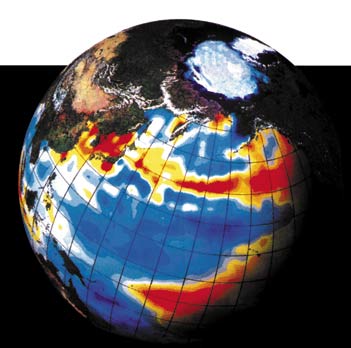 |
| Many completely different factors such as the distance between Earth and Sun, the planet's rotational speed, the inclination of its axes, and the geographical features of the surface all combine to ensure that our world is heated in just the right way that life needs and that this heat is adequately distributed. |
The rotational speed of the Earth on its axes also helps keep the thermal distribution in balance. The Earth makes a complete rotation once every 24 hours with the result that alternating periods of daylight and darkness are fairly short. Because they are short, the thermal gradient between the light and dark sides of the planet are quite modest. The importance of this can be seen in the extreme example of Mercury, where a day lasts longer than a year and where the difference between daytime and nighttime temperatures is almost 1,000°C.
Geography also helps distribute heat equally over the earth. There is a difference of about 100°C between the polar and equatorial regions of Earth. If such a thermal gradient were to exist over a completely level area, the result would be winds reaching speeds as high as 1,000 kilometers an hour sweeping away everything in their path. Instead, Earth is full of geographical barriers that block the huge movements of air that such a thermal gradient would otherwise cause. Those barriers are chains of mountains like the one that stretches from the Pacific in the east to the Atlantic in the west, beginning with the Himalayas in China and continuing with the Taurus mountains in Anatolia and the Alps in Europe. At sea, the excess heat in the equatorial regions is transferred north and south by means of the superior ability of the water to conduct and dissipate heat.
At the same time, there are a number of auto-control systems that help keep the atmospheric temperature in balance. For example when a region heats up, the rate at which its water vaporizes increases, causing clouds to form. These clouds reflect more light back into space, preventing both the air and the surface below from getting warmer.
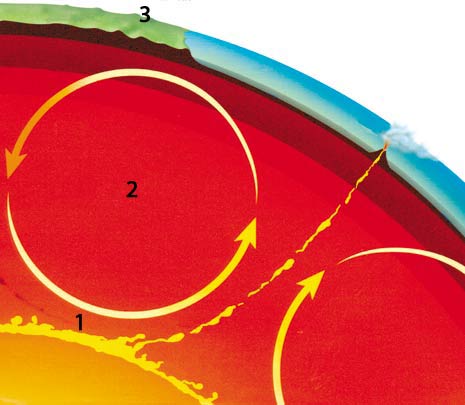 |
| 1. Iron-nickel core |
| At the center of the Earth there's a sort of heatdriven engine that is so perfectly adjusted that it is strong enough to generate the planet's magnetic shield yet not so strong as to engulf the crust above in lava. |
The size of Earth is no less important for life than are its distance from the Sun, its rotational speed, or geographical features. Looking at the planets we see a great range of sizes: Mercury is less than a tenth the size of Earth while Jupiter is 318 times bigger. Is the size of Earth as compared with other planets "coincidental"? Or is it deliberate?
When we examine the dimensions of Earth we can easily see that our planet was created to be exactly as big as it is. American geologists Frank Press and Raymond Siever comment on Earth's "fitness":
And Earth's size was just about right–not too small as to lose its atmosphere because its gravity was too small to prevent gasses from escaping into space, and not so large that its gravity would hold on to too much atmosphere, including harmful gases.58
In addition to its mass, the interior of Earth is also specially created. Because of its core, Earth has a strong magnetic field whose role in the preservation of life is vital. According to Press and Siever:
The earth's interior is a gigantic but delicately balanced heat engine fueled by radioactivity …Were it running more slowly, geological activity would have proceeded at a slower pace. Iron might not have melted and sunk to form the liquid core, and the magnetic field would never have developed…if there had been more radioactive fuel and a faster running engine, volcanic gas and dust would have blotted out the Sun, the atmosphere would have been oppressively dense, and the surface would have been racked by daily earthquakes and volcanic explosions.59
The magnetic field these geologists talk about is of great importance for life. This magnetic field originates from the structure of Earth's core. The core consists of heavy elements like iron and nickel that are capable of holding a magnetic charge. The inner core is solid while the outer one is liquid. The two layers of the core move around each other and this movement is what generates Earth's magnetic field. Extending far beyond the surface, this field protects Earth from the effects of detrimental radiation from outer space. The radiation of stars other than the Sun cannot travel through this shield. The Van Allen Belt, whose magnetic lines extend ten thousand miles from Earth, protects the globe from this deadly energy.
It is calculated that the plasma clouds trapped by the Van Allen Belt sometimes attain energy levels 100 billion times more powerful than that the atomic bomb released over Hiroshima. Cosmic rays may be equally detrimental. The Earth's magnetic field however lets only 0.1% of that radiation through and that is absorbed by the atmosphere. The electrical energy needed to create and maintain such a magnetic field is nearly a billion amperes, as much as mankind has generated throughout history.
If this protective shield did not exist, life would be destroyed by harmful radiation from time to time and might not have come into existence at all. But as Press and Siever point out, Earth's core is exactly created to keep the planet safe.
In other words, there is a special purpose as stated in the Qur'an:
We made the sky a persevered and protected roof yet still they turn away from Our signs. (Surat al-Anbiya’: 32)
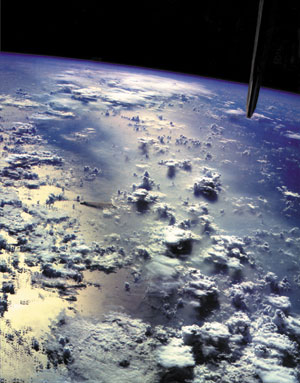 |
| Earth's atmosphere as seen from above by NASA astronauts while over the Philippines. |
As we have seen, Earth's physical features–mass, structure, temperature and so on–are "just right for life". Such features alone are not enough to allow life to exist on Earth however. Another vital factor is the composition of the atmosphere.
We noted above how science-fiction movies sometimes mislead people. One example of how they do this is how easily space travelers and explorers come across planets with breathable atmospheres: they seem to be lying all over the place. If we could explore the real universe, we'd discover that this isn't true at all: the possibility of another planet's having an atmosphere that we could breathe is most unlikely. That's because the atmosphere of Earth is specially created to support life in a number of crucial ways.
The atmosphere of Earth is composed of 77% nitrogen, 21% oxygen, and 1% carbon dioxide. Let's start with the most important gas: oxygen. Oxygen is vitally important to life because it enters into most of the chemical reactions that release the energy that all complex life-forms require.
Carbon compounds react with oxygen. As a result of these reactions, water, carbon dioxide, and energy are produced. Small "bundles" of energy that are called ATP (adenosine triphosphate) and are used in living cells are generated by these reactions. This is why we constantly need oxygen to live and why we breathe to satisfy that need.
The interesting aspect of this business is that the percentage of oxygen in the air we breathe is very precisely determined. Michael Denton writes on this point:
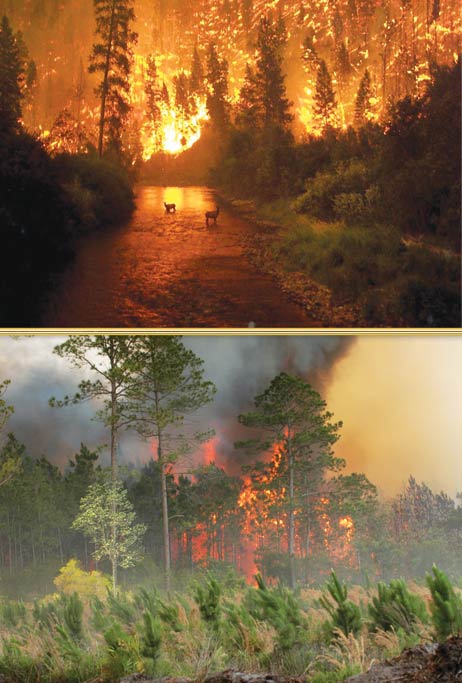 |
Could your atmosphere contain more oxygen and still support life? No! Oxygen is a very reactive element. Even the current percentage of oxygen in the atmosphere, 21 percent, is close to the upper limit of safety for life at ambient temperatures. The probability of a forest fire being ignited increases by as much as 70 percent for every 1 percent increase in the percentage of oxygen in the atmosphere.60
According to the British biochemist James Lovelock:
Above 25% very little of our present land vegetation could survive the raging conflagrations which would destroy tropical rain forests and arctic tundra alike... The present oxygen level is at a point where risk and benefit nicely balance.61
That the proportion of oxygen in the atmosphere remains at this precise value is the result of a marvelous "recycling" system: Animals constantly consume oxygen and produce carbon dioxide, which, for them, is not breathable. Plants do just the opposite: they take in carbon dioxide, which they need to live, and release oxygen instead. By means of this system, life goes on. Plants release millions of tons of oxygen into the atmosphere every day.
Without the cooperation and balance of these two different groups of living things, our planet would be unlivable. For example, if living things only took in carbon dioxide and released oxygen, the Earth's atmosphere would support combustion much more easily than it does and even a tiny spark could set off enormous fires. Similarly, if both took in oxygen and released carbon dioxide, life would eventually die out when all the oxygen had been used up.
In fact, the atmosphere is in a state of equilibrium in which, as Lovelock says, risk and benefit are nicely balanced.
Another finely-tuned aspect of our atmosphere is its density, which is ideally suited for us to breathe.
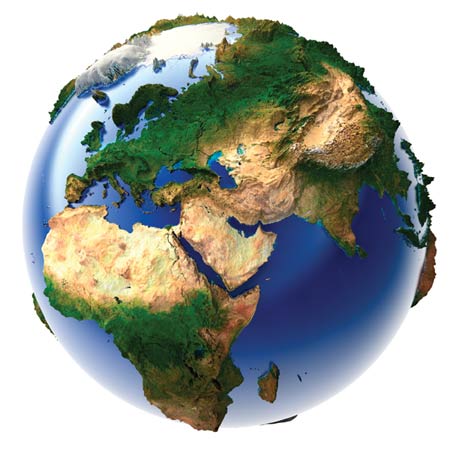 |
We breathe every moment of our lives. We continuously take the air into our lungs and let it out. We do it so much that we might think of it as normal. In fact, respiration is quite a complex process.
Our bodily systems are so perfectly created that we don't need to think about breathing. Our body estimates how much oxygen it needs and arranges for the delivery of the right amount whether we're walking, running, reading a book, or sleeping. The reason breathing is so important to us is that the millions of reactions that must constantly take place in our bodies to keep us alive all require oxygen.
Your ability to read this book is due to the millions of cells in the retina of your eye constantly being supplied with oxygen-derived energy. Similarly, all the tissues of our bodies and the cells forming them get their energy from the "burning" of carbon compounds in oxygen. The product of this burning–carbon dioxide–must be discharged from the body. If the level of oxygen in your bloodstream drops to low, the result is fainting; and if the absence of oxygen persists for more than a few minutes, the result is death.
And that's why we breathe. When we inhale, oxygen floods into about 300 million tiny chambers in our lungs. Capillary veins attached to these chambers absorb the oxygen in a twinkling and convey it first to heart and then to every other part of our body. The cells of our body use this oxygen and release carbon dioxide into the blood, which conveys it back to the lungs where it is expelled. The whole thing takes less than half a second: "clean" oxygen comes in and "dirty" carbon dioxide goes out.
You might be wondering why there are so many (300 million) of those little chambers in the lungs. They're there to maximize the surface area that is exposed to the air. They're carefully folded up to occupy as little space as possible; if they were unfolded, the result would be enough to cover a tennis court.
There is another point here that we need to keep in mind. The chambers of the lungs and the capillaries connecting to them are created so small and perfectly in order to increase the rate at which oxygen and carbon dioxide are exchanged. But that perfect structure depends on other factors: the density, viscosity, and pressure of air must all be right in order for the air to move properly in and out of our lungs.
At sea level, air pressure is 760 mm of mercury and its density is about 1 gram/liter. Again at sea level, its viscosity is nearly 50 times that of water. You might think these numbers unimportant but they are vital for our lives because, as Michael Denton notes:
The overall composition and general character of the atmosphere–its density, viscosity, and pressure, etc–must be very similar to what it is, particularly for air-breathing organisms. 62
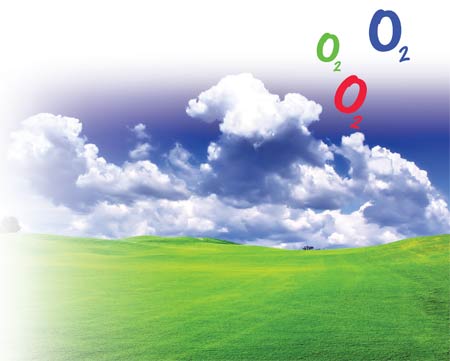 |
When we breathe, our lungs use energy to overcome a force called "airway resistance". This force is the result of the resistance of air to movement. Owing to the physical properties of the atmosphere however, this resistance is weak enough that our lungs can take air in and let it out with a minimum expenditure of energy. If air resistance were higher, our lungs would be forced to work harder to enable us to breathe. This can be explained by an example. It easy to draw water into the needle of an injector but drawing honey in is much more difficult. The reason is that honey is denser than water and also more viscous.
If the density, viscosity, and pressure of air were higher, breathing would be as difficult as drawing honey into a needle. Someone might say "That's easy to fix. We'll just make the hole of the needle larger to increase the rate of flow." But if we did that in the case of the capillaries in the lungs, the result would be to reduce the size of the area in contact with air, with the result that less oxygen and carbon dioxide would be exchanged in the same amount of time and the respiratory needs of the body would not be satisfied. In other words, the individual values of air's density, viscosity and pressure must all fall within certain limits in order for it to be breathable and those of the air we breathe do exactly that.
Michael Denton comments on this:
It is clear that if either the viscosity or the density of air were much greater, the airway resistance would be prohibitive and no conceivable redesign of the respiratory system would be capable of delivering sufficient oxygen to a metabolically active air-breathing organism... By plotting all possible atmospheric pressures against all possible oxygen contents, it becomes clear that there is only one unique tiny area... where all the various conditions for life are satisfied... It is surely of enormous significance that several essential conditions are satisfied in this one tiny region in the space of all possible atmospheres.63
The numerical values of the atmosphere are not only necessary for us to breathe but are also essential for our Blue Planet to stay blue. If sea-level atmospheric pressure were much lower than its present value, the rate of water vaporization would be much higher. Increased water in the atmosphere would have a "greenhouse effect" trapping more heat and raising the average temperature of the planet. On the other hand, if the pressure were much higher, the rate of water vaporization would be less, turning large parts of the planet into desert.
All these finely-tuned equilibriums indicate that our atmosphere has been created precisely so that life on Earth can exist. This is the reality discovered by science and it shows us again that the universe is not just an accidental jumble of matter. Undoubtedly there is a Creator ruling the universe, shaping matter as He wants it to be, and reigning over the galaxies, stars and planets under His sovereignty.
That supreme power, as the Qur'an tells us, is Allah, Lord of the whole universe.
And the Blue Planet on which we live is specially created and "smoothed out" by Allah for people as stated in the Qur'an. (Surat an-Nazi’at: 30) There are other verses revealing that Allah has created Earth for mankind to live in:
It is Allah Who made the earth a stable home for you and the sky a dome, and formed you, giving you the best of forms, and provided you with good and wholesome things. That is Allah, your Lord. Blessed be Allah, the Lord of all the worlds. (Surah Ghafir: 64)
It is He Who made the earth submissive to you, so walk its broad trails and eat what it provides. The Resurrection is to Him. (Surat al-Mulk: 15)
The things we have mentioned so far are just a few of the delicate equilibriums that are essential for life on Earth. Examining the earth, we can make the list of the "essential factors for life" a long as we please. The American astronomer Hugh Ross has made a list of his own:
Surface Gravity;
If stronger: atmosphere would retain too much ammonia and methane
Distance From Parent Star;
Thickness of crust;
Rotation period;
Gravitational interaction with Moon;
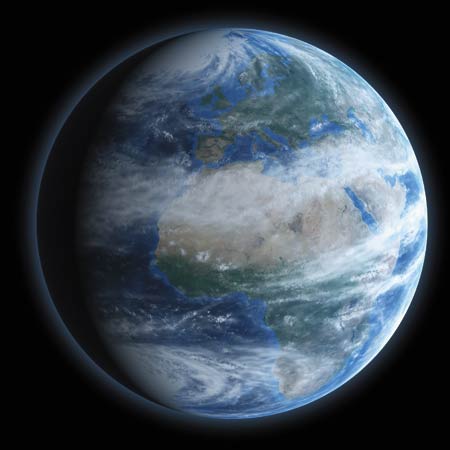 |
Magnetic Field;
Albedo (Ratio of Reflected light to total amount falling on surface);
If less: runaway greenhouse effect would develop
Oxygen to nitrogen ratio in the atmosphere;
if smaller: advanced life functions would proceed too slowly
Carbon dioxide and water vapor levels in atmosphere;
Ozone level in Atmosphere;
Seismic Activity;
These are just some of the features that the Earth has to have in order for life to exist and survive. But even these are enough to show that the Earth did not come into being as a result of chance nor was it formed as a result of a lucky chain of events.
These and a myriad other details reaffirm a plain and simple truth: Allah and Allah alone created the universe, the stars, planets, mountains, and seas perfectly, giving life to human beings and other living things, and placing His creations under the control of mankind. Allah and Allah alone, the source of mercy and might, is powerful enough to create something from nothingness.
This perfect Creation of Allah is described in the Qur'an thus:
Are you stronger in structure or is heaven? He built it. He raised its vault high and made it level. He darkened its night and brought forth its morning light. After that He smoothed out the earth and brought forth from it its water and its pastureland and made the mountains firm for you and for your livestock to enjoy. (Surat an-Nazi'at: 27-33)
54. F. Press, R. Siever, Earth, New York: W. H. Freeman, 1986, p. 2 ![]()
55. See. Harun Yahya, The Evolution Deceit: The Scientific Collapse of Darwinism and Its Ideological Background, Istanbul, 1998. ![]()
56. Michael Denton, Nature's Destiny, s. 106 ![]()
57. F. Press, R. Siever, Earth, New York: W. H. Freeman, 1986, p. 4 ![]()
58. F. Press, R. Siever, Earth, New York: W. H. Freeman, 1986, p. 4 ![]()
59. F. Press, R. Siever, Earth, New York: W. H. Freeman, 1986, p. 4 ![]()
60. Michael Denton, Nature's Destiny, p. 121 ![]()
61. James J. Lovelock, Gaia, Oxford: Oxford University Press, 1987, p. 71 ![]()
62. Michael Denton, Nature's Destiny, p. 127 ![]()
63. Michael Denton, Nature's Destiny, p. 128 ![]()
64.Hugh Ross, The Fingerprint of God: Recent Scientific Discoveries Reval the Unmistakable Identity of the Creator, Oranga, California, Promise Publishing, 1991, p 129-132 ![]()